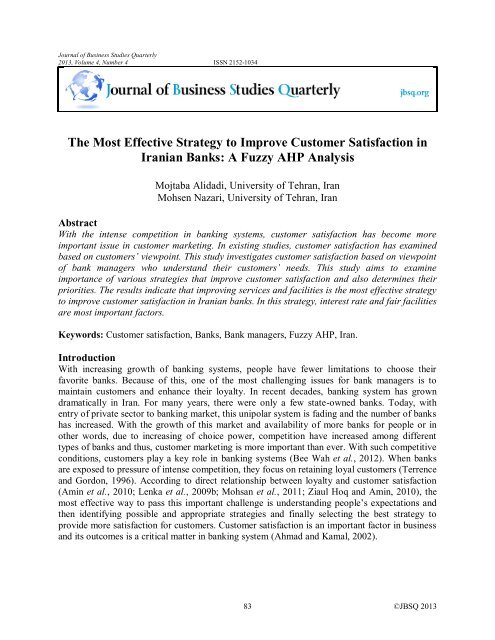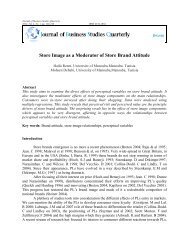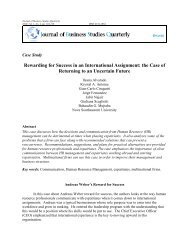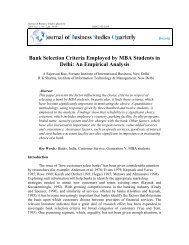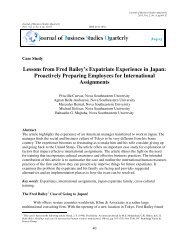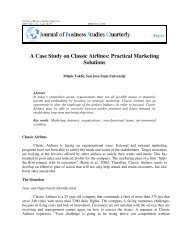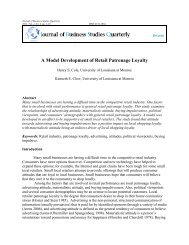The Most Effective Strategy to Improve Customer Satisfaction in ...
The Most Effective Strategy to Improve Customer Satisfaction in ...
The Most Effective Strategy to Improve Customer Satisfaction in ...
You also want an ePaper? Increase the reach of your titles
YUMPU automatically turns print PDFs into web optimized ePapers that Google loves.
Journal of Bus<strong>in</strong>ess Studies Quarterly2013, Volume 4, Number 4 ISSN 2152-1034<strong>The</strong> <strong>Most</strong> <strong>Effective</strong> <strong>Strategy</strong> <strong>to</strong> <strong>Improve</strong> Cus<strong>to</strong>mer <strong>Satisfaction</strong> <strong>in</strong>Iranian Banks: A Fuzzy AHP AnalysisMojtaba Alidadi, University of Tehran, IranMohsen Nazari, University of Tehran, IranAbstractWith the <strong>in</strong>tense competition <strong>in</strong> bank<strong>in</strong>g systems, cus<strong>to</strong>mer satisfaction has become moreimportant issue <strong>in</strong> cus<strong>to</strong>mer market<strong>in</strong>g. In exist<strong>in</strong>g studies, cus<strong>to</strong>mer satisfaction has exam<strong>in</strong>edbased on cus<strong>to</strong>mers’ viewpo<strong>in</strong>t. This study <strong>in</strong>vestigates cus<strong>to</strong>mer satisfaction based on viewpo<strong>in</strong><strong>to</strong>f bank managers who understand their cus<strong>to</strong>mers’ needs. This study aims <strong>to</strong> exam<strong>in</strong>eimportance of various strategies that improve cus<strong>to</strong>mer satisfaction and also determ<strong>in</strong>es theirpriorities. <strong>The</strong> results <strong>in</strong>dicate that improv<strong>in</strong>g services and facilities is the most effective strategy<strong>to</strong> improve cus<strong>to</strong>mer satisfaction <strong>in</strong> Iranian banks. In this strategy, <strong>in</strong>terest rate and fair facilitiesare most important fac<strong>to</strong>rs.Keywords: Cus<strong>to</strong>mer satisfaction, Banks, Bank managers, Fuzzy AHP, Iran.IntroductionWith <strong>in</strong>creas<strong>in</strong>g growth of bank<strong>in</strong>g systems, people have fewer limitations <strong>to</strong> choose theirfavorite banks. Because of this, one of the most challeng<strong>in</strong>g issues for bank managers is <strong>to</strong>ma<strong>in</strong>ta<strong>in</strong> cus<strong>to</strong>mers and enhance their loyalty. In recent decades, bank<strong>in</strong>g system has growndramatically <strong>in</strong> Iran. For many years, there were only a few state-owned banks. Today, withentry of private sec<strong>to</strong>r <strong>to</strong> bank<strong>in</strong>g market, this unipolar system is fad<strong>in</strong>g and the number of bankshas <strong>in</strong>creased. With the growth of this market and availability of more banks for people or <strong>in</strong>other words, due <strong>to</strong> <strong>in</strong>creas<strong>in</strong>g of choice power, competition have <strong>in</strong>creased among differenttypes of banks and thus, cus<strong>to</strong>mer market<strong>in</strong>g is more important than ever. With such competitiveconditions, cus<strong>to</strong>mers play a key role <strong>in</strong> bank<strong>in</strong>g systems (Bee Wah et al., 2012). When banksare exposed <strong>to</strong> pressure of <strong>in</strong>tense competition, they focus on reta<strong>in</strong><strong>in</strong>g loyal cus<strong>to</strong>mers (Terrenceand Gordon, 1996). Accord<strong>in</strong>g <strong>to</strong> direct relationship between loyalty and cus<strong>to</strong>mer satisfaction(Am<strong>in</strong> et al., 2010; Lenka et al., 2009b; Mohsan et al., 2011; Ziaul Hoq and Am<strong>in</strong>, 2010), themost effective way <strong>to</strong> pass this important challenge is understand<strong>in</strong>g people’s expectations andthen identify<strong>in</strong>g possible and appropriate strategies and f<strong>in</strong>ally select<strong>in</strong>g the best strategy <strong>to</strong>provide more satisfaction for cus<strong>to</strong>mers. Cus<strong>to</strong>mer satisfaction is an important fac<strong>to</strong>r <strong>in</strong> bus<strong>in</strong>essand its outcomes is a critical matter <strong>in</strong> bank<strong>in</strong>g system (Ahmad and Kamal, 2002).83©JBSQ 2013
Level 1Level 2AHP is an useful technique for decision makers <strong>to</strong> rank <strong>in</strong>formation based on several criteria(Beynon, 2002). It also is a prom<strong>in</strong>ent management <strong>to</strong>ol <strong>to</strong> support multi-criteria decisionproblems on several qualitative fac<strong>to</strong>rs (Lee et al., 2012).Cus<strong>to</strong>mer satisfaction is a mental concept and relates <strong>to</strong> personal experiences. This causes moreuncerta<strong>in</strong>ty <strong>in</strong> managers’ judgments and consequently <strong>in</strong> pairwise comparisons. Because of this,Fuzzy Analytical Hierarchy Process (F-AHP) is found more effective rather than AHP. Inaddition, select<strong>in</strong>g appropriate criteria and sub-criteria is necessary <strong>to</strong> reach more accurateresults.F-AHP hierarchical tree (figure 1) breaks down process <strong>in</strong><strong>to</strong> smaller elements and subsequentlycauses better understand<strong>in</strong>g of relationship with<strong>in</strong> and between each level. Each criterion <strong>in</strong> level1 and sub criterion <strong>in</strong> level 2 is compared with the other <strong>in</strong> pairwise form <strong>to</strong> determ<strong>in</strong><strong>in</strong>gpriorities.Figure 1: F-AHP hierarchical treeGoalCriterion (1)Criterion (2)Criterion (n)SubCriterion(1.1)SubCriterion(1.n)SubCriterion(n.1)SubCriterion(n.n)SubCriterion(2.1)SubCriterion(2.n)Accord<strong>in</strong>g <strong>to</strong> Extent Analysis (EA) method that <strong>in</strong>troduced by Chang (1996), two triangularfuzzy numbers (TFN) is assumed:(1)(2)<strong>The</strong>se fuzzy numbers is shown <strong>in</strong> figure 2.Mathematical opera<strong>to</strong>rs are as follows:(3)85©JBSQ 2013
(4)(5)(6)Above equations are just approximation of product, sum and reverse of two triangular fuzzynumbers.Figure 2: Triangle fuzzy number M 1 & M 210l 1 m 1 l 2 u 1m 2 u 2Accord<strong>in</strong>g <strong>to</strong> verbal terms <strong>in</strong> questionnaire that must be considered <strong>in</strong> pairwise comparisonmatrix, an appropriate scale for conversion of those terms <strong>to</strong> fuzzy numbers is requir<strong>in</strong>g.Triangular fuzzy importance scale is shown <strong>in</strong> table 1 (Tolga et al., 2005, p. 101).Table 1: Triangular fuzzy importance scaleL<strong>in</strong>guistic scaleEqual importance(EI)Moderateimportance (MI)Strong importance(SI)Very strongimportance (VSI)Demonstratedimportance (DI)ExplanationTwo activities contribute equally <strong>to</strong> theobjectiveExperience and judgment slightlyfavor one activity over anotherExperience and judgment stronglyfavor one activity over anotherAn activity is favored very stronglyover another; its dom<strong>in</strong>ancedemonstrated <strong>in</strong> practice<strong>The</strong> evidence favor<strong>in</strong>g one activityover another is the highest possibleTriangularfuzzy scaleTriangularfuzzyreciprocalscale(1,1,1) (1,1,1)(1/2,1,3/2) (2/3,1,2)(1,3/2,2) (1/2,2/3,1)(3/2,2,5/2) (2/5,1/2,2/3)(2,5/2,3) (1/3,2/5,1/2)86
When ( ) show the fuzzy evaluation of sample members ,geometric mean of all comparisons could be used as follows:(7)In EA method, value of extent analysis ( that is a triangle number) is calculated for all rows ofpairwise comparison matrix with m rows and n columns:(8)After that, possibility degree must be calculated. <strong>The</strong> possibility degree of <strong>to</strong> that weshow it byis def<strong>in</strong>ed as follows:(9)(10)Possibility degree of one TFN <strong>to</strong> other k TFN is obta<strong>in</strong>ed by below equation:For calculat<strong>in</strong>g weight of criteria <strong>in</strong> pairwise comparison matrix In EA method, we do asfollows:<strong>The</strong>refore, criteria weight vec<strong>to</strong>r is as follows:As previously mentioned, select<strong>in</strong>g appropriate criteria and sub-criteria is so important <strong>to</strong>achieve more accurate results. We set 4 criteria and 17 sub-criteria based on expert op<strong>in</strong>ions (by<strong>in</strong>terview) <strong>in</strong> Iranian bank<strong>in</strong>g system, viewpo<strong>in</strong>t of bank managers (by <strong>in</strong>terview) who havedirect communication with their cus<strong>to</strong>mers and understand their needs, previous researches(Abedniya et al., 2011; Her<strong>in</strong>g<strong>to</strong>n and Weaven, 2009; Mihelis et al., 2001; Norma, 2012;Ramdhani et al., 2011; Vazifehdoust and Hosse<strong>in</strong>zadeh Lotfi, 2012) that often show viewpo<strong>in</strong><strong>to</strong>f bank cus<strong>to</strong>mers. Each of these criteria <strong>in</strong>cludes several sub-criteria (Table 2).(11)(12)(13)87©JBSQ 2013
Table 2: Criteria and sub-criteria for FAHP modelCriteriaImprov<strong>in</strong>g environmental fac<strong>to</strong>rsImprov<strong>in</strong>g staff tra<strong>in</strong><strong>in</strong>gImprov<strong>in</strong>g subjective imag<strong>in</strong>ationImprov<strong>in</strong>g services and facilitiesSub CriteriaClean and arranged environment, Enough space,Proximity <strong>to</strong> public transportation l<strong>in</strong>es,Personal appearanceResponsiveness, Availability, Sufficientknowledge, Consider<strong>in</strong>g of compla<strong>in</strong>ts,Friendly behaviorBrand management, Advertisement, SocialresponsibilityVariety, Interest rate, Electronic / onl<strong>in</strong>e servicesand call center, Speed of do<strong>in</strong>g tasks, FairfacilitiesAs previously mentioned, there are 2 levels <strong>in</strong> this F-AHP model, criteria (level 1), and subcriteria(level 2).Figure 3: Criteria and sub-criteria <strong>in</strong> F-AHP hierarchical treeIncrease cus<strong>to</strong>mersatisfactionImprov<strong>in</strong>genvironmental fac<strong>to</strong>rsImprov<strong>in</strong>g stafftra<strong>in</strong><strong>in</strong>gImprov<strong>in</strong>g subjectiveimag<strong>in</strong>ationImprov<strong>in</strong>g servicesand facilitiesClean and arrangedenvironmentResponsivenessBrand managementVarietyEnough spaceAvailabilityAdvertisementInterest rateProximity <strong>to</strong> publictransportation l<strong>in</strong>esSufficientknowledgeSocial responsibilityElectronic / onl<strong>in</strong>eservices and callcenterPersonal appearanceConsider<strong>in</strong>g ofcompla<strong>in</strong>tsSpeed of do<strong>in</strong>g tasksFriendly behaviorFair facilities88
Results50 questionnaires were delivered <strong>to</strong> bank managers; each questionnaire has 5 questions with 5pairwise comparison charts. Comparisons were done with numbers that <strong>in</strong>dicates verbal terms <strong>in</strong>Table 1. 15 questionnaires were not analyzable. Inconsistency ratio (IR) <strong>in</strong> 5 questionnaires wasmore than 0.1 and we returned 5 questionnaires <strong>to</strong> managers <strong>to</strong> review pairwise comparisons.F<strong>in</strong>ally, 35 correct questionnaires (IR
Priorities and importance weights of sub-criteria (level 2) with respect <strong>to</strong> services and facilitiesobta<strong>in</strong>ed as below:Table 3: weights of fac<strong>to</strong>rs for <strong>in</strong>creas<strong>in</strong>g cus<strong>to</strong>mer satisfactionCriteria (level 1) weights Sub-criteria (level2) weightsClean and decentenvironment0.267Improv<strong>in</strong>g0.180enough space 0.229environmental fac<strong>to</strong>rsProximity <strong>to</strong> public0.262transportation l<strong>in</strong>esPersonal appearance 0.241Improv<strong>in</strong>g stafftra<strong>in</strong><strong>in</strong>gImprov<strong>in</strong>g subjectiveimag<strong>in</strong>ationImprov<strong>in</strong>g servicesand facilities0.2870.2340.298Responsiveness 0.230Availability 0.173Sufficient knowledge 0.218Consider<strong>in</strong>g ofcompla<strong>in</strong>ts0.184Friendly behavior 0.195Brand management 0.31610Advertisement 0.31618Social responsibility 0.3677Variety 0.1927Interest rate 0.2118Electronic / onl<strong>in</strong>eservices and call center0.1962Speed of do<strong>in</strong>g tasks 0.1960Fair facilities 0.2031ConclusionAccord<strong>in</strong>g <strong>to</strong> the results <strong>in</strong> Table 3, from view po<strong>in</strong>t of bank managers who <strong>in</strong>teract with theircus<strong>to</strong>mers and understand their needs, improv<strong>in</strong>g services and facilities is the most effectivestrategy (29.8%) <strong>to</strong> <strong>in</strong>crease satisfaction among cus<strong>to</strong>mers. In this criterion, <strong>in</strong>terest rate and fairfacilities are most important sub-criteria. <strong>The</strong> second effective strategy is improv<strong>in</strong>g stafftra<strong>in</strong><strong>in</strong>g (28.7%). In this criterion, tra<strong>in</strong><strong>in</strong>g staffs <strong>to</strong> be more responsiveness and <strong>in</strong>creasesufficient knowledge of them are most important sub-criteria. <strong>The</strong> third effective strategy isimprov<strong>in</strong>g subjective imag<strong>in</strong>ation (23.4%). In this criterion, commitment <strong>to</strong> social responsibilityis the most important sub-criterion. <strong>The</strong> last effective strategy is improv<strong>in</strong>g environmentalfac<strong>to</strong>rs (18%). In this criterion, make a clean and decent environment and proximity of bank <strong>to</strong>public transportation l<strong>in</strong>es are most important sub-criteria.Totally, this study shows that <strong>in</strong> order <strong>to</strong> <strong>in</strong>crease cus<strong>to</strong>mer satisfaction, bank managers shouldfocus on provid<strong>in</strong>g better services and facilities. Actually this is the most effective strategy. Thiscould be achieved strongly by <strong>in</strong>creas<strong>in</strong>g <strong>in</strong>terest rate and give fair facilities <strong>to</strong> cus<strong>to</strong>mers. <strong>The</strong>seresults show that Iranian bank managers <strong>in</strong>dicate that their cus<strong>to</strong>mers are satisfied by economicservices and also bank managers state that loan and facilities are not provid<strong>in</strong>g <strong>in</strong> a fair manner.90
This classification of strategies for <strong>in</strong>creas<strong>in</strong>g cus<strong>to</strong>mer satisfaction and determ<strong>in</strong><strong>in</strong>g theirpriorities is so useful for bank managers and policy makers <strong>in</strong> Iranian bank<strong>in</strong>g <strong>in</strong>dustry.ReferencesAbedniya, A., Nokhbeh Zaeim, M. and Yousef Hakimi, B. (2011), "Investigat<strong>in</strong>g the Relationshipbetween Cus<strong>to</strong>mers’ Perceived Service Quality and <strong>Satisfaction</strong>: Islamic Bank <strong>in</strong> Malaysia",European Journal of Social Sciences, Vol. 21 No. 4, pp. 603-624.Ahmad, J. and Kamal, N. (2002), "Cus<strong>to</strong>mer satisfaction and retail bank<strong>in</strong>g: an assessment of some of thekey antecedents of cus<strong>to</strong>mer satisfaction <strong>in</strong> retail bank<strong>in</strong>g", International Journal of BankMarket<strong>in</strong>g, Vol. 20 No. 4, pp. 146-160.Am<strong>in</strong>, M., Isa, Z. and Fonta<strong>in</strong>e, R. (2010), "<strong>The</strong> role of cus<strong>to</strong>mer satisfaction <strong>in</strong> enhanc<strong>in</strong>g cus<strong>to</strong>merloyalty <strong>in</strong> Malaysian Islamic banks", <strong>The</strong> Service Industries Journal, Vol. 31 No. 9, pp. 1519-1532.Amudha, R., Surulivel, S. T. and Vijaya Banu, C. (2012), "A Study on Cus<strong>to</strong>mer <strong>Satisfaction</strong> <strong>to</strong>wardsQuality of Service of an Indian Private Sec<strong>to</strong>r Bank us<strong>in</strong>g Fac<strong>to</strong>r Analysis", European Journal ofSocial Sciences, Vol. 29 No. 1, pp. 12-25.Bee Wah, Y., Ramayah, T. and Wan Nushazel<strong>in</strong> Wan, S. (2012), "<strong>Satisfaction</strong> and trust on cus<strong>to</strong>merloyalty: a PLS approach", Bus<strong>in</strong>ess <strong>Strategy</strong> Series, Vol. 13 No. 4, pp. 154-167.Beynon, M. (2002), "DS/AHP method: A mathematical analysis, <strong>in</strong>clud<strong>in</strong>g an understand<strong>in</strong>g ofuncerta<strong>in</strong>ty", European Journal of Operational Research, Vol. 140 No. 1, pp. 148-164.Cao, S.-Y., Wang, W.-H. and Zhang, H.-F. (2011), "Research and application on cus<strong>to</strong>mer satisfactiondegree evaluation system <strong>in</strong> call centers of commercial bank", <strong>in</strong> 2011 International Conferenceon Bus<strong>in</strong>ess Management and Electronic Information (BMEI),Guangzhou, 13-15 May 2011,IEEE, Guangzhou, pp. 803-807.Chang, D.-Y. (1996), "Applications of the extent analysis method on fuzzy AHP", European Journal ofOperational Research, Vol. 95 No. 3, pp. 649-655.Ghazizadeh, M., Soleimani Besheli, A. and Talebi, V. (2010), "A Survey of Brand Equity and Cus<strong>to</strong>mer<strong>Satisfaction</strong> of Iranian State-Owned Banks", European Journal of Social Sciences, Vol. 17 No. 2,pp. 266-273.Her<strong>in</strong>g<strong>to</strong>n, C. and Weaven, S. (2009), "E-retail<strong>in</strong>g by banks: e-service quality and its importance <strong>to</strong>cus<strong>to</strong>mer satisfaction", European Journal of Market<strong>in</strong>g, Vol. 43 No. 9, pp. 1220-1231.J<strong>in</strong>-Fu, W. and Long, H. (2012), "Empirical Study on Cus<strong>to</strong>mers’ <strong>Satisfaction</strong> of Commercial Bank withMotivation-Hygiene <strong>The</strong>ory", <strong>in</strong>: HU, W. (Ed.), Advances <strong>in</strong> Electric and Electronics, Spr<strong>in</strong>ger-Verlag, Berl<strong>in</strong> Heidelberg, pp. 707-714.Kordnaeij, A., Danaeefard, H., Zali, M. R. and Vasheghani, S. (2012), "<strong>The</strong> Role of OrganizationalCulture <strong>in</strong> Cus<strong>to</strong>mer <strong>Satisfaction</strong>", European Journal of Economics, F<strong>in</strong>ance and Adm<strong>in</strong>istrativeSciences, Vol. No. 51, pp. 146-157.91©JBSQ 2013
Lee, S., Kim, W., Kim, Y. M. and Oh, K. J. (2012), "Us<strong>in</strong>g AHP <strong>to</strong> determ<strong>in</strong>e <strong>in</strong>tangible priority fac<strong>to</strong>rsfor technology transfer adoption", Expert Systems with Applications, Vol. 39 No. 7, pp. 6388-6395.Lenka, U., Suar, D. and Mohapatra, P. K. J. (2009a), "Cus<strong>to</strong>mer satisfaction <strong>in</strong> Indian commercial banksthrough <strong>to</strong>tal quality management approach", Total Quality Management, Vol. 21 No. 12, pp.1315-1341.Lenka, U., Suar, D. and Mohapatra, P. K. J. (2009b), "Service Quality, Cus<strong>to</strong>mer <strong>Satisfaction</strong>, andCus<strong>to</strong>mer Loyalty <strong>in</strong> Indian Commercial Banks", Journal of Entrepreneurship, Vol. 18 No. 1, pp.47-64.Mcdonald, L. M. and Rundle-Thiele, S. (2008), "Corporate social responsibility and bank cus<strong>to</strong>mersatisfaction: A research agenda", International Journal of Bank Market<strong>in</strong>g, Vol. 26 No. 3, pp.170-182.Mihelis, G., Grigoroudis, E., Siskos, Y., Politis, Y. and Malandrakis, Y. (2001), "Cus<strong>to</strong>mer satisfactionmeasurement <strong>in</strong> the private bank sec<strong>to</strong>r", European Journal of Operational Research, Vol. 130No. 2, pp. 347-360.Mishra, U. S., Mishra, B. B., Biswal, S. K. and Mishra, B. B. (2010), "Employee Evaluations of Cus<strong>to</strong>mer<strong>Satisfaction</strong>: A Comparative Study between Public and Private Banks <strong>in</strong> India", InternationalResearch Journal of F<strong>in</strong>ance and Economics, Vol. No. 59, pp. 134-144.Mohsan, F., Nawaz, M. M., Khan, M. S., Shaukat, Z. and Aslam, N. (2011), "Impact of Cus<strong>to</strong>mer<strong>Satisfaction</strong> on Cus<strong>to</strong>mer Loyalty and Intentions <strong>to</strong> Switch: Evidence from Bank<strong>in</strong>g Sec<strong>to</strong>r ofPakistan", International Journal of Bus<strong>in</strong>ess & Social Science, Vol. 2 No. 16, pp. 263-270.Mout<strong>in</strong>ho, L. and Smith, A. (2000), "Modell<strong>in</strong>g bank cus<strong>to</strong>mer satisfaction through mediation of attitudes<strong>to</strong>wards human and au<strong>to</strong>mated bank<strong>in</strong>g", International Journal of Bank Market<strong>in</strong>g, Vol. 18 No. 3,pp. 124-134.Nicholls, J. a. F., Roslow, S. and Tsalikis, J. (1995), "BANK TRANSACTIONS: SATISFACTION ANDCUSTOMER ATTRIBUTES", Journal of Market<strong>in</strong>g Management, Vol. 5 No. 1, pp. 39-45.Norma, M. S. (2012), "Comparative Analysis of Cus<strong>to</strong>mer <strong>Satisfaction</strong> on Islamic and ConventionalBanks <strong>in</strong> Malaysia", Asian Social Science, Vol. 8 No. 1, pp. 73-80.Ramdhani, M. A., Ramdhani, A. and Mariam Kurniati, D. (2011), "<strong>The</strong> Influence Of Service QualityToward Cus<strong>to</strong>mer <strong>Satisfaction</strong> Of Islamic Sharia Bank", Australian Journal of Basic and AppliedSciences, Vol. 5 No. 9, pp. 1099-1104.Terrence, L. and Gordon, H. G. M. (1996), "Determ<strong>in</strong>ants of cus<strong>to</strong>mer satisfaction <strong>in</strong> retail bank<strong>in</strong>g",International Journal of Bank Market<strong>in</strong>g, Vol. 14 No. 7, pp. 12-20.Tolga, E., Demircan, M. L. and Kahraman, C. (2005), "Operat<strong>in</strong>g system selection us<strong>in</strong>g fuzzyreplacement analysis and analytic hierarchy process", International Journal of ProductionEconomics, Vol. 97 No. 1, pp. 89-117.92
Vazifehdoust, H., Ram, M. and Hosse<strong>in</strong>zadeh Lotfi, F. (2012), "Rank<strong>in</strong>g the Influential Fac<strong>to</strong>rs onCus<strong>to</strong>mer’s <strong>Satisfaction</strong> Us<strong>in</strong>g Fuzzy Technique <strong>in</strong> Banks", Applied Mathematical Sciences, Vol.6 No. 3, pp. 129-139.W<strong>in</strong>nie, Y.-L. W. and Kanji, G. K. (2001), "Measur<strong>in</strong>g cus<strong>to</strong>mer satisfaction: Evidence from Hong Kongretail bank<strong>in</strong>g <strong>in</strong>dustry", Total Quality Management, Vol. 12 No. 7-8, pp. 939-948.Yu, S.-H. (2007), "An Empirical Investigation on the Economic Consequences of Cus<strong>to</strong>mer <strong>Satisfaction</strong>",Total Quality Management & Bus<strong>in</strong>ess Excellence, Vol. 18 No. 5, pp. 555-569.Ziaul Hoq, M. and Am<strong>in</strong>, M. (2010), "<strong>The</strong> role of cus<strong>to</strong>mer satisfaction <strong>to</strong> enhance cus<strong>to</strong>mer loyalty",African Journal of Bus<strong>in</strong>ess Management, Vol. 4 No. 12, pp. 2385-2392.93©JBSQ 2013


